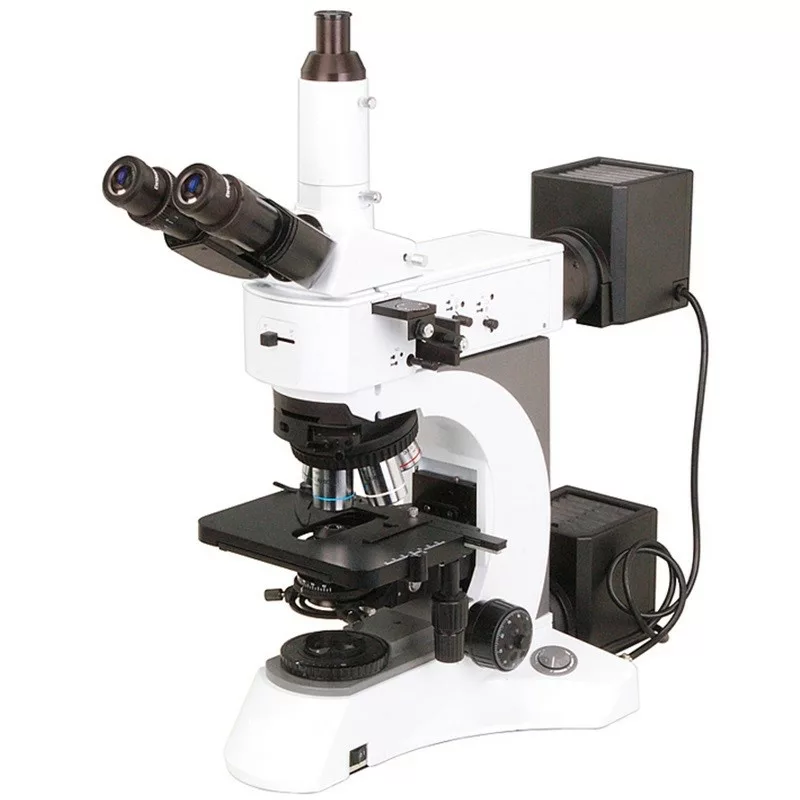Metallurgical Microscope (Transmit and Reflect Light): Unveiling Precision for Metallurgical Analysis
A Metallurgical Microscope KMM/T/20 is a specialized optical instrument designed for analyzing metals, alloys, and other materials. Used extensively in industries like metallurgy, manufacturing, quality control, and research, this microscope enables detailed observation of the structural components of metals, from grain boundaries to inclusions and surface defects. Whether you are involved in failure analysis, product development, or metallographic research, a metallurgical microscope is an indispensable tool that enhances material integrity and product quality.
What is a Metallurgical Microscope?
A Metallurgical Microscope is optimized for observing opaque samples like metals, ceramics, and other solid materials that do not allow light to pass through. Unlike biological microscopes that work with transparent specimens, metallurgical microscopes use reflected light to reveal the surface details and internal structure of metals. This tool helps metallurgists and materials scientists conduct metallographic analysis, inspecting the microstructure of metals at magnifications that can reach up to 1,000x or more.
Key Features of a Metallurgical Microscope
When selecting a Metallurgical Microscope, it’s essential to consider specific features that enhance its performance for metallurgical applications:
- Reflected Light Illumination: These microscopes use an epi-illumination system, which directs light onto the specimen and reflects it back to the viewer, enabling the examination of opaque materials.
- High Magnification Power: High-quality metallurgical microscopes provide magnification ranges suitable for detailed analysis, from 50x to 1,000x or more, revealing even the smallest surface irregularities.
- Polarization and DIC Capabilities: For improved contrast and enhanced structural detail, metallurgical microscopes often feature polarization or Differential Interference Contrast (DIC) techniques, which are crucial for examining the crystalline structure of metals.
- Durable Stage and Body: Designed to accommodate heavy or large specimens, metallurgical microscopes feature sturdy stages and robust construction that support the rigors of industrial and laboratory use.
- Digital Imaging and Measurement: Many modern metallurgical microscopes come equipped with digital cameras or compatibility for capturing images and performing detailed measurements, facilitating precise analysis and documentation.
- Versatile Objectives: Metallurgical microscopes typically come with a variety of objective lenses (ranging from low to high magnification) to allow flexibility depending on the type of material and the desired detail level.
Applications of Metallurgical Microscopes
Metallurgical Microscopes are used across numerous industries for quality control, research, and development. Key applications include:
- Failure Analysis: Inspect failed components for structural flaws such as cracks, inclusions, or deformations. A metallurgical microscope reveals the root cause of the failure, guiding repairs and material improvements.
- Quality Control: Monitor the consistency of material properties by examining the microstructure of metals and alloys during the manufacturing process. This ensures that products meet stringent specifications and performance criteria.
- Research and Development: Researchers use metallurgical microscopes to study the crystalline structure of metals and alloys, exploring ways to enhance material performance, durability, and resistance to wear or corrosion.
- Weld Inspection: Assess the integrity of weld joints by analyzing the microstructure, ensuring that welded products meet industry standards for strength and durability.
- Coating Analysis: Examine the thickness and uniformity of coatings, such as protective layers on metals, to ensure they meet functional and aesthetic requirements.
- Heat Treatment Studies: Analyze the effects of heat treatments on the grain structure and phase distribution within metals, providing valuable insights into optimizing processing techniques.
Benefits of Using a Metallurgical Microscope
Using a Metallurgical Microscope offers a range of advantages for professionals in metallurgy, materials science, and industrial manufacturing:
- Enhanced Detail and Accuracy: The high magnification and advanced optical systems of metallurgical microscopes reveal minute structural details, enabling precise material analysis.
- Non-Destructive Testing: Metallurgical microscopes allow for in-depth material analysis without damaging or altering the specimen, preserving its integrity for further examination or testing.
- Improved Product Quality: By identifying flaws, defects, and inconsistencies early in the production process, manufacturers can make necessary adjustments to ensure high-quality finished products.
- Informed Decision-Making: The insights gained from microstructural analysis enable engineers and researchers to make informed decisions regarding material selection, processing, and failure prevention.
- Documentation and Reporting: Digital imaging capabilities allow users to capture high-resolution images and data, which can be used for reporting, research publications, or customer assurance.
Choosing the Right Metallurgical Microscope
Selecting the right Metallurgical Microscope depends on your specific applications, budget, and required features. Here are some considerations:
- Magnification Range: Consider the level of detail you need. Higher magnifications are essential for microstructural analysis, while lower magnifications may suffice for surface inspections.
- Optical Quality: A high-quality optical system ensures clear, sharp images, minimizing aberrations and distortions for accurate analysis.
- Illumination Type: Ensure the microscope has appropriate reflected light systems, and consider additional lighting options like LED or halogen bulbs for enhanced visibility.
- Camera Integration: Many modern microscopes come with built-in or compatible digital cameras, making it easy to capture, store, and share images for analysis or documentation.
- Stage Flexibility: If you work with larger or irregular specimens, ensure the stage can handle the weight and size without compromising stability or accuracy.
- Software Compatibility: If digital analysis is critical to your work, look for a microscope that integrates with image analysis software for advanced measurement, image stitching, or 3D visualization.
Industries That Rely on Metallurgical Microscopes
- Aerospace: Metallurgical microscopes help ensure that critical components used in aircraft meet stringent safety standards through failure analysis and quality control.
- Automotive: Inspect metals and alloys used in engines, frames, and other automotive parts to ensure durability and performance.
- Steel Manufacturing: Analyze steel microstructures for grain size, phase distribution, and inclusions to maintain product integrity.
- Electronics: Inspect solder joints, electronic components, and microcircuits for defects, ensuring the reliability of devices.
- Defense and Military: Evaluate the integrity of materials used in defense applications, including weapons systems and armor plating, where material failure can be catastrophic.
How to Use a Metallurgical Microscope for Optimal Results
Operating a Metallurgical Microscope is straightforward with the right preparation:
- Prepare the Specimen: Polish or etch the metal surface if necessary to enhance visibility of grain structures and other features.
- Set the Lighting: Adjust the reflected light to illuminate the specimen surface adequately.
- Select the Magnification: Choose an appropriate objective lens based on the level of detail required.
- Focus the Image: Use the fine adjustment knob to achieve a sharp, clear image of the sample’s surface.
- Capture Data: If your microscope has digital capabilities, capture images or videos of your observations for further analysis or documentation.
Conclusion
A Metallurgical Microscope is an essential tool for anyone involved in the analysis of metals and alloys, providing the magnification and resolution necessary to inspect microstructures, identify defects, and improve product quality. Whether for failure analysis, research, or quality control, these microscopes offer precision, durability, and advanced features that meet the needs of various industries.





Reviews
There are no reviews yet.